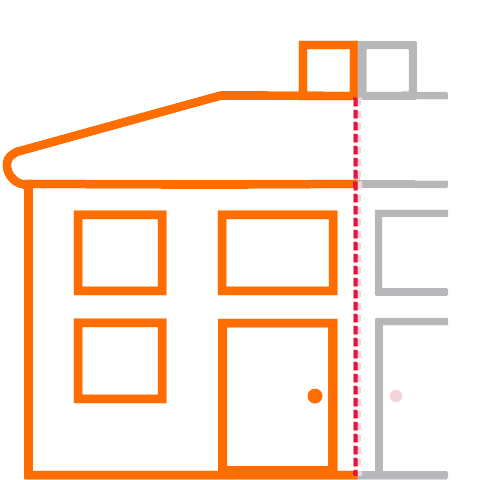In the UK for 2024, you'll need to meet specific loft insulation requirements to comply with building regulations. Your loft must have a minimum insulation thickness of 270mm and achieve a U-value of 0.2 W/m²K for effective heat retention. Between-joist insulation requires at least 100mm of wool insulation for energy efficiency and sound reduction. You can choose from various materials, including mineral wool, fiberglass, or foam board insulation, but all must meet fire safety standards for at least 30 minutes. Proper ventilation is essential to prevent moisture-related issues, and professional installation guarantees peak performance. Understanding these technical specifications is just the beginning of maximizing your home's energy efficiency.
Minimum Insulation Requirements
Table of Contents
ToggleBuilding regulations in the UK lay down strict minimum insulation requirements for loft spaces. You'll need to verify your loft meets the mandatory 270mm insulation thickness, which is essential for maintaining peak energy efficiency in your home.
This requirement isn't arbitrary – it's been calculated to achieve the recommended U-value of 0.2 W/m²K, which measures how effectively your insulation prevents heat transfer.
When you're planning your loft insulation, you'll need to install a 100mm wool insulation layer between the floor joists, which serves a dual purpose. Not only does it enhance your home's energy efficiency, but it also helps reduce sound transmission between floors.
You should be aware that inadequate insulation can lead to significant heat loss, potentially up to 25% of your home's heat escaping through a poorly insulated loft.
Additionally, you'll need to verify all insulation materials you use meet fire safety standards, with materials required to maintain fire resistance for at least 30 minutes.
These requirements aren't just recommendations – they're mandatory standards that help verify your loft conversion is both safe and energy-efficient.
Types of Loft Insulation Materials
With modern building standards becoming increasingly stringent, you'll find several effective loft insulation materials available in the UK market. Each material offers distinct advantages that you'll need to evaluate when making your selection, particularly as all options must meet the required U-value of 0.2 W/m²K.
Mineral wool stands out as a popular choice due to its impressive fire resistance and sound-dampening qualities, making it an excellent option if you're prioritizing safety and noise reduction in your home.
You'll find fiberglass insulation particularly appealing if you're looking for a lightweight solution, as it effectively resists moisture while delivering ideal thermal performance at the recommended thickness of 270mm.
For spaces where you're working with limited headroom, foam board insulation provides an efficient alternative, delivering high R-values in a notably thinner profile than traditional materials.
When you're selecting your insulation material, you'll need to weigh these options against your specific requirements, considering factors such as available space, moisture concerns, and fire safety needs.
Each material type can meet building regulations when properly installed, ensuring your loft maintains energy efficiency standards.
U-Value Standards and Measurements
Understanding U-values forms the cornerstone of effective loft insulation in the UK. When you're planning your loft insulation, you'll need to achieve a U-value of 0.2 W/m²K, which represents the current standard for thermal efficiency in residential properties. This measurement precisely indicates how well your insulation prevents heat from escaping through your roof space.
To meet these requirements, you'll need to install a minimum of 270mm of insulation material during your loft conversion, which isn't just a recommendation but a mandatory requirement under current building regulations. Without proper attention to these standards, you could be losing up to 25% of your home's heat through inadequate insulation.
The U-value calculation takes into account your insulation material's thermal resistance properties, ensuring you're achieving peak energy efficiency in your home.
When you're installing insulation that meets these U-value standards, you're not only complying with regulations but also gaining additional benefits. The proper thickness and installation of materials that achieve the 0.2 W/m²K standard will contribute to improved sound insulation, making your living space more comfortable while maintaining thermal efficiency.
Between-Joist Insulation Specifications
Proper between-joist insulation requires specific attention to detail and precise measurements. You'll need to guarantee that your insulation meets the minimum requirement of 100mm wool thickness, which helps maximize energy efficiency while reducing unwanted sound transmission throughout your loft space.
When you're installing between-joist insulation, you must maintain strict adherence to the building regulations' U-value requirement of 0.2 W/m²K or less. The spacing between your floor joists shouldn't exceed 6mm, and you'll want to use C24 grade timber for the joists to properly support the standard imposed weight of 1.5kN/m². This combination guarantees both structural integrity and ideal thermal performance.
It's essential that you pay careful attention to moisture control during installation. You'll need to implement proper moisture barriers and ventilation measures, as incorrect installation can lead to condensation buildup between the joists.
This moisture accumulation, if left unchecked, can compromise your loft's structural elements over time. By following these specifications precisely, you'll create an insulation system that meets regulatory requirements while protecting your loft's long-term durability.
Energy Efficiency Compliance Guidelines
Three key requirements define the UK's energy efficiency compliance for loft insulation in 2024. You'll need to guarantee your loft conversion meets the mandatory minimum insulation thickness of 270mm, achieve a U-value rating of 0.2 W/m²K, and implement proper ventilation measures to prevent moisture-related issues.
To comply with these standards, you'll want to work closely with qualified professionals who can verify that your insulation installation meets current building regulations. The specified U-value of 0.2 W/m²K serves as a significant benchmark, measuring how effectively your chosen insulation material prevents heat transfer through your loft space.
When you're planning your conversion, remember that proper insulation can cut your home's heat loss by up to 25%, making it a vital investment in your property's energy efficiency.
You'll also need to balance insulation with adequate ventilation, as this combination prevents condensation and mold growth while maintaining structural integrity. Your contractor should assess your specific requirements and confirm that all materials and installation methods align with current building codes, helping you achieve both compliance and peak energy performance.
Ventilation and Moisture Control
While meeting insulation standards is fundamental, effective ventilation holds equal importance in your loft's overall performance.
You'll need to guarantee proper airflow throughout your loft space to prevent moisture accumulation, which can otherwise lead to serious structural issues and mold growth.
When you're installing insulation to meet the recommended U-value of 0.2 W/m²K, you must simultaneously maintain adequate ventilation to achieve peak energy efficiency.
You'll find that without proper ventilation, even the best insulation can't perform effectively, potentially resulting in increased energy costs and heat loss.
To comply with current building regulations, you'll need to implement a balanced approach that includes strategic placement of vents in your eaves, ridge vents, or other appropriate openings that promote consistent airflow.
You should consider ventilation as part of an integrated system, where insulation and air circulation work together to maintain a healthy living environment.
It's critical that you don't block or restrict ventilation points when installing insulation, as this can create condensation problems that'll compromise both your loft's structure and its thermal performance.
Installation Best Practices
For successful loft insulation, you'll need to follow vital installation practices that guarantee both compliance and peak performance.
You'll want to make sure your insulation meets the mandatory 270mm thickness requirement while achieving a U-value of 0.2 W/m²K, which is critical for ideal thermal efficiency in your home.
When installing insulation between floor joists, you should lay 100mm of wool insulation material, which will provide both thermal protection and sound reduction benefits.
As you work through the installation process, you'll need to maintain proper ventilation pathways to prevent moisture accumulation, which can greatly compromise your insulation's effectiveness and potentially damage your property's structure.
While you might be tempted to tackle this project independently, it's important to work with qualified professionals who understand current building regulations.
They'll make sure your installation complies with all necessary standards and codes, particularly when dealing with complex aspects such as maintaining adequate ventilation while maximizing insulation coverage.
Your contractor should verify that all measurements meet specifications and that the installation provides consistent coverage throughout the loft space.





